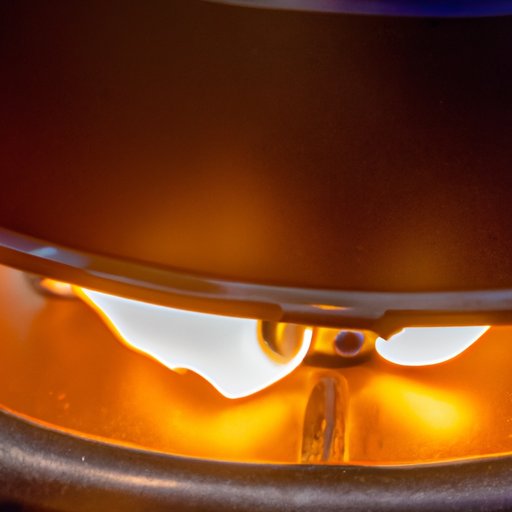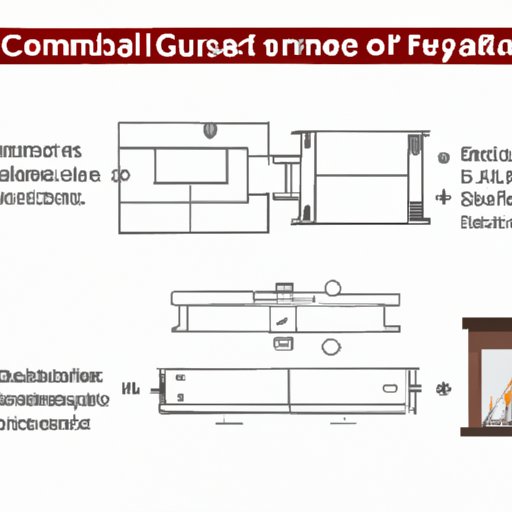
I. Introduction
A gas fireplace is a reliable, convenient, and low-maintenance alternative to traditional wood-burning fireplaces. A gas fireplace operates through a natural gas line or propane gas tank, giving off warmth and ambiance at the flick of a switch. However, lighting a gas fireplace may not be as straightforward as one might expect, especially if you are unfamiliar with the components and the process. This article offers a comprehensive guide on how to light a gas fireplace.

II. Understanding the Components of a Gas Fireplace
Before you light your gas fireplace, it is crucial to understand the basic components. Typically, there are four essential components in any gas fireplace:
A. Pilot Light
The pilot light is a small flame that ignites the fuel in your gas fireplace. It is essential to keep the pilot light lit because it determines whether your gas fireplace will turn on or not. Gas fireplaces with an electronic ignition system do not have a pilot light because they ignite the gas automatically.
B. Burner
The burner is responsible for distributing the gas into the fireplace to create flames. It is designed to deliver gas in the right quantities to produce the right amount of heat and flames. Most gas fireplaces have burners made of stainless steel or cast iron.
C. Gas Valve
The gas valve controls the flow of gas to the fireplace. It usually has a knob that you can use to turn the gas on and off. The valve also controls the gas pressure to ensure that the fireplace operates safely and efficiently.
D. Thermocouple
The thermocouple is a safety device that shuts off the gas supply if the pilot light goes out unexpectedly. It does this by detecting the temperature of the pilot light and sending a signal to shut off the gas valve if the temperature drops too low.
E. Other Essential Components
Other components of a gas fireplace include the gas line, which delivers gas to the fireplace, and the chimney or vent, which removes the by-products of combustion from the house. Some gas fireplaces also have fans to circulate warm air around the room.
III. Different Types of Gas Fireplaces and Their Unique Lighting Techniques
There are three primary types of gas fireplaces: vented, ventless, and direct-vent. Each type has unique lighting techniques and safety precautions.
A. Vented Gas Fireplaces
Vented gas fireplaces are designed to mimic the look of a wood-burning fireplace, with open flames and realistic logs. They require a vent or chimney to remove the combustion by-products from the house. Vented gas fireplaces are known for their efficiency in heating large rooms.
B. Ventless Gas Fireplaces
Ventless gas fireplaces operate without a chimney or vent, making them easier and cheaper to install. They are popular in small apartments or homes without chimneys. However, ventless gas fireplaces are illegal in some states and can pose safety risks if not installed or operated correctly.
C. Direct-Vent Gas Fireplaces
Direct-vent gas fireplaces are similar to vented gas fireplaces, but they use a sealed glass front to prevent heat loss and improve efficiency. They have a two-part venting system that draws combustion air from outside the house and exhausts it outside. Direct-vent gas fireplaces are easy to install and have flexible venting options.
IV. A Step-by-Step Guide on Lighting a Gas Fireplace
A. Preparing to Light the Gas Fireplace
Before you light your gas fireplace, ensure that all the components are in place. Check that the gas supply to the fireplace is turned on. Make sure the chimney or vent is clear of debris. Have a fireplace lighter, fireplace key, or long match ready to use.
B. Lighting the Pilot Light
Locate the pilot light assembly, which is usually found behind the logs in the fireplace. Turn the gas valve to the “pilot” position and press down on the knob to let gas flow to the pilot light. Use the lighter or match to ignite the flame. Hold down the knob for 30 seconds to allow the thermocouple to heat up and keep the pilot light lit. If the pilot light goes out, repeat the process.
C. Adjusting the Flame
Once the pilot light is lit, turn the gas valve to the “on” position to ignite the burner and flames. Adjust the flame using the control knob next to the gas valve. Be mindful of the color of the flame; blue flames indicate that your gas fireplace is burning clean and efficient, while yellow flames mean that your fireplace needs cleaning or servicing.
D. Turning off the Gas Fireplace
When you are ready to turn off your gas fireplace, first turn the control knob to “off” to stop the flow of gas to the burner. Wait for the fireplace to cool down before turning off the pilot light.
V. Common Mistakes People Make When Lighting a Gas Fireplace
Lighting a gas fireplace may seem simple, but some common mistakes may pose risks to your safety or damage your fireplace. Be aware of the following errors:
A. Not Lighting the Pilot Light
Sometimes the pilot light may be out, and you may fail to notice it. Always check the pilot light before lighting the burner.
B. Using the Wrong Lighter
Use a fireplace lighter or a long match to light the pilot light. Do not use an ordinary lighter or a regular matchstick because they may not be long enough to reach the pilot light.
C. Not Adjusting the Flame
Adjust the flame to your desired heat level. A flame that is too low may cause soot, while a flame that is too high may damage your fireplace.
D. Other Common Mistakes
Other mistakes include failing to clean the gas fireplace regularly, using the wrong gas supply line, and leaving the gas fireplace unattended.
VI. Overcoming Challenges When Lighting a Gas Fireplace
Even with the proper preparation, lighting a gas fireplace may not always go smoothly. Here are some common problems and how to solve them:
A. Weak Pilot Light
A weak pilot light may indicate that the thermocouple is dirty or damaged. Use a wire brush or sandpaper to clean the thermocouple, or call a professional to replace it.
B. Clogged Gas Lines
Gas lines can become clogged with debris or rust, preventing the proper flow of gas. Call a professional to inspect and clean the gas line.
C. Fluctuating Flame
Fluctuating flames may be caused by a dirty or faulty burner, insufficient gas pressure, or a clogged or dirty pilot light. Check and clean these components or call a professional to inspect them.
D. Other Challenges and Solutions
Other issues include a faulty gas valve, a damaged thermocouple, or a gas leak – all of which require the assistance of a professional. Do not attempt to fix these issues on your own.
VII. Safety Tips for Lighting a Gas Fireplace
Lighting a gas fireplace requires caution and attention to safety. Follow these tips to ensure safe operation:
A. Checking the Vents
Check the vents or chimney for obstructions or debris that may prevent proper ventilation.
B. Staying Alert as Gas Is Being Used
Always pay attention to the gas fireplace when it’s in use and never leave it unattended. If you smell gas, turn off the gas supply and call a professional.
C. Having a Suitable Fire Extinguisher Nearby
Have a fire extinguisher nearby in case of emergencies, and ensure that you know how to use it.
D. Other Important Safety Tips
Other safety tips include never using gasoline, kerosene, or any other flammable liquid to ignite your fireplace and keeping flammable items away from the fireplace.
VIII. Importance of Annual Inspections for Gas Fireplaces
Annual inspections are crucial for maintaining the efficiency and safety of your gas fireplace. A professional technician can identify and fix problems before they become serious. They can also assess the overall condition of your fireplace and offer recommendations for better operation.
A. Explanation of the Benefits of Scheduling Annual Inspections
Regular maintenance ensures that your gas fireplace operates reliably, efficiently, and safely. An annual inspection can extend the life of your gas fireplace, prevent costly repairs, and boost energy efficiency.
B. What to Expect During an Inspection
During an inspection, a professional technician will examine the gas line, pilot light, burner, gas valve, and other components. They will evaluate the condition of these parts and clean or repair them as needed. They will also ensure that the fireplace meets the required safety standards.
C. Other Important Information
Be proactive and schedule an annual inspection with a qualified technician. If you notice any strange noises, unusual odors, or changes in flame quality, call a professional for assistance.
IX. Conclusion
Lighting a gas fireplace is an easy and convenient way to warm your home and create a cozy ambiance. However, safety should always be a top priority when working with gas appliances. By following the outlined steps and taking reasonable precautions, you can safely operate your gas fireplace and enjoy the warmth and comfort it provides.
Remember, always schedule annual inspections and seek professional assistance if you encounter any problems or need help with installation or repairs.





